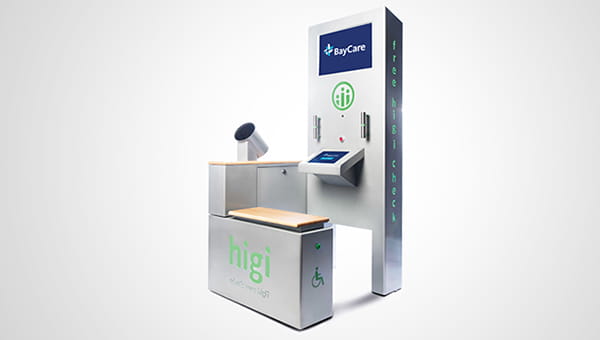About High Blood Pressure
Blood pressure is the force created when blood is pushing against the artery walls. It’s generated each time the heart beats (contracts and relaxes) as blood is pumped from the heart into the blood vessels. Blood pressure is written as two numbers. These two numbers are:
- The top number, or systolic pressure, refers to the pressure inside the artery when the heart contracts and pumps blood through the body.
- The bottom number, or diastolic pressure, refers to the pressure inside the artery when the heart is at rest and is filling with blood.
When blood pressure is high, the arteries have an increased resistance against the flow of blood, causing the heart to pump harder to circulate the blood. High blood pressure, or hypertension, directly increases the risk of heart disease, heart attack and stroke. When high blood pressure does not respond to at least three medications, it’s called resistant hypertension. The blood pressure chart below showcases the normal, acceptable blood pressure ranges for adults:
| Blood Pressure Category | SYSTOLIC mm Hg (upper number) |
And/or | DIASTOLIC mm Hg (lower number) |
| Normal | Less than 120 | And | Less than 80 |
| Elevated | 120-129 | And | Less than 80 |
| Hypertension Stage 1 (high blood pressure) |
130-139 |
or |
80-89 |
| Hypertension Stage 2 (high blood pressure) |
140 or higher |
or |
90 or higher |
| Hypertension Crisis | Higher than 180 | And/or | Higher than 120 |
For more information about blood pressure readings, visit the American Heart Association.
- Chest pain
- Shortness of breath
- Back pain
- Numbness
- Weakness
- Change in vision
- Difficulty speaking
- Confusion
- Dizziness
- Vomiting
If you have a sudden onset of symptoms such as chest pain, chest pressure, chest tightness, or severe shortness of breath, you may be experiencing a medical emergency. Call 911 immediately.
Causes and Risk Factors
Nearly one-third of all Americans have high blood pressure. Some risk factors and causes include:
- People who have diabetes, gout or kidney disease
- Being African American, especially those who live in the southeastern United States
- Being in your middle adult years; men in this age group have higher blood pressure more often than women in this age group
- Being in your middle to later adult years; women in this age group have higher blood pressure more often than men in this age group (more women have high blood pressure after menopause than men of the same age)
- Being middle-aged or elderly; more than half of all Americans age 60 and older have high blood pressure
- Having a family history of high blood pressure
- Being overweight or obese
- Drinking alcohol heavily
- Being a women taking oral contraceptives
- Being a pregnant woman with gestational hypertension or preeclampsia
- Having a diet with excessive salt intake
- Lacking exercise and physical activity
Diagnosing High Blood Pressure
Blood pressure can change throughout the day and with different activities, so it's important to check it regularly to detect high blood pressure. You are diagnosed with high blood pressure (hypertension) if your systolic (top number) is 130 mm Hg or higher, or your diastolic (bottom number) is 80 mm Hg or higher, measured on two or more separate visits to your doctor.
To make this diagnosis, your doctor may ask you to monitor your blood pressure at home. Home blood pressure monitors are commonly recommended, but you can also ask your doctor about a newer option called ambulatory blood pressure monitoring (ABPM). ABPM tracks your blood pressure over 24 hours for more accurate results, but it requires a doctor's prescription.
Additionally, there are free resources, like BayCare Wellness Stations, where you can check your blood pressure in the community.
Here are some tips for an accurate blood pressure reading:
- Check your blood pressure on a consistent schedule.
- Relax or rest in the 5-10 minutes before taking your blood pressure.
- Avoid exercise, other stimulants (like caffeine or nicotine), or stressors in the hour leading up to taking your blood pressure.
- Keep your feet flat on the floor and do not cross your legs or ankles while taking your blood pressure.
- Make sure the blood pressure cuff comes in direct contact with your skin and the arm used is well supported on a table or other surface at the height of your chest.
- Use the restroom to empty your bladder before taking your blood pressure.
- Avoid talking while taking your blood pressure.
-
Lifestyle Changes
-
Medications
-
Renal Denervation Procedure
While there is no cure for high blood pressure, lifestyle changes can help to improve blood pressure. It’s important to talk with your doctor about the lifestyle changes that may be best for you. Some recommended lifestyle changes include:
- Eating a well-balanced diet
- Limiting alcohol
- Enjoying regular physical activity
- Managing stress
- Maintaining a healthy weight
- Quit smoking
- Choosing foods that are low in salt
- Diuretics (water pills): These medications help remove sodium (salt) and water from your body.
- Angiotensin-converting enzyme (ACE) inhibitors: Drugs that prevent your body from changing the angiotensin hormone to angiotensin II that plays a key role in raising blood pressure.
- Angiotensin II receptor blockers (ARBs): Medications that block the protein angiotensin II, preventing it from narrowing the blood vessels.
- Alpha blockers: Drugs that relax the smaller blood vessels by blocking a body hormone called norepinephrine.
- Calcium channel blockers: Medications that block calcium to relax the muscles in the blood vessels.
- Beta blockers: Drugs that can help widen the blood vessels and help the heart beat slower.
- Vasodilators: Medications that help to keep the muscles in the artery walls relaxed and prevent them from narrowing or tightening.
-
Why is it important to treat my high blood pressure if I have no symptoms?Over time, high blood pressure causes the heart to work harder and can cause serious health problems like a stroke, heart attack, coronary artery disease, heart failure, and problems with your kidneys and eyes. If high blood pressure is well managed or controlled, these serious health conditions may be avoidable.
-
Why is high blood pressure often nicknamed “the silent killer"?Since high blood pressure may not have any noticeable signs or symptoms, it can often go undiagnosed for long periods of time, causing damage to the body. The first recognizable symptom for some may be a medical emergency like a heart attack or stroke. Even with immediate medical care or intervention, these emergencies sometimes result in death. This highlights the importance of detecting high blood pressure early and managing it to help prevent medical emergencies.
-
Can blood pressure be too low?
Also known as hypotension, low blood pressure can be dangerous since it causes a lack of blood flow to important organs like the brain and heart. Symptoms of low blood pressure can include dizziness, lightheadedness, fainting (syncope), nausea, vomiting, and sleepiness. If you have any of these symptoms combined with cold, clammy, or bluish-looking skin, or rapid breathing or heartbeat, call 911 and seek immediate medical attention.
Low blood pressure can be caused by a variety of things including dehydration, blood loss, medications, anemia, heart attack or heart failure. If you suspect or find that you have low blood pressure, its important to talk to your doctor.

The New High Blood Pressure Guidelines
Dr. Dan Sodano explains the new high blood pressure guidelines, and offers his best advice on how to lower and maintain good blood pressure. Learn more about BayCare’s heart and vascular services.
Need a cardiac specialist?
Call us at (855) 233-0888 or fill out the form to request a referral to a cardiac specialist.




